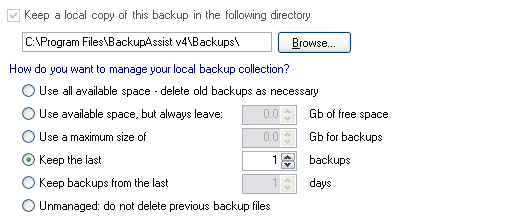Local copies: specifying a disk location for backup files before FTP upload

Accessing local copies options
To access the Local copies options shown above:
- Click
 Jobs in the navigation bar.
Jobs in the navigation bar. - Select the job to be edited and click
 Edit at the bottom of the window.
Edit at the bottom of the window. - Click
 Destination on the left menu.
Destination on the left menu. - Click
Keep local copies of your backups to expand the section.
Here you can specify the temporary disk location (local hard drive, network drive, etc) where the .bkf backup file is stored before being uploaded directly to your FTP server. A default location is set when the job is first created. The backup copy is also useful for redundancy purposes (an extra level of protection in case the original backup file is lost or corrupted) and for quick restore of data from a local and readily available drive (no requirement to establish a connection to the FTP server to download data over a slower connection). You can also determine how the disk space of the secondary backup location is managed.
- Specify the location where the backup files should be stored temporarily before being uploaded, either by typing in the path directly or browsing for it.
- Specify how disk space should be managed on the secondary location:
- Use all available space (recommended)
BackupAssist will check the secondary location for free disk space while copying the backup file. If the drive is running low in disk space and cannot accommodate the backup file copy, the oldest backup file on the drive will be removed. BackupAssist will continue to remove backup files in age order as required to ensure that enough space is free to store the new backup file. If your entire secondary location is dedicated to backup storage this option is recommended. - Use available space but always leave X Gb of free space
Here you can define an amount of disk space to always leave free on the drive of the secondary location. BackupAssist will check the drive for free disk space while a backup is in progress and if the drive's free space goes below this value, the oldest backup file will be removed from the secondary location. BackupAssist will continue to remove backup files in age order as required to ensure that this amount of free space is always maintained on the secondary location. - Use a maximum size of X Gb for backups
Here you can define a maximum amount of disk space that should be used for backup storage on the secondary location. BackupAssist will scan the drive for backup files while a backup is in progress and if the amount of disk space used for backup files goes above this value, the oldest backup file will be removed from the drive. BackupAssist will continue to remove backup files in age order as required to ensure that backup storage does not exceed this value of disk space. - Keep the last X backups
Here you can determine the number of backup files that should be constantly maintained on the secondary location. BackupAssist will delete the oldest backup on the drive if this number of backup file copies is ever exceeded. - Keep backups from the last X days
Here you can choose to have BackupAssist remove any backup files on the secondary location that are older than a specified number of days. For example: you may like to set this value to "14" to always have the last two week's worth of backup copies on the drive. - Unmanaged
Here BackupAssist will continue to fill your secondary location with backup files. You will need to manually manage the disk space yourself. If the drive ever runs out of space and the copy cannot complete you will receive an error in your backup report alerting you to this fact.